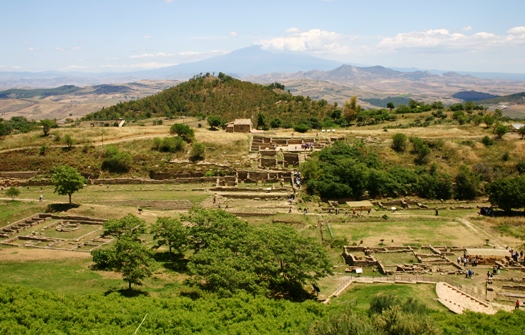After being looted and sold to the Metropolitan Museum, the stunning collection of 3rd century BC silver pieces known as the silver hoard of Morgantina has come back to Aidone in Sicily. It’s an arduous task to get to this remote town, a real off-the-beaten-path adventure in Sicily, but I can assure you that it’s worth the trip.
On a recent visit, I found the silver pieces breathtaking – exquisitely crafted bowls, drinking vessels and other pieces left me and other lucky visitors gasping in awe. The silver hoard is beautifully displayed in the tiny archeological museum of Aidone, and in the same museum you will find the Goddess of Morgantina, a Greek statue that also has a murky past, having come home to rest after having been looted and sold to the Getty Museum.
We can include a visit to the Morgantina archeological site, Aidone archaeology museum as well as the spectacular mosaics at Piazza Armerina on a private tour in Sicily.
The looting, sale and investigation of the Morgantina silver is also a fascinating story.
Considered to be among the finest Hellenistic silver known from Magna Grecia, the pieces were purchased by Metropolitan Museum of Art in the early 1980’s for $2.74 million from Robert Hecht Jr,, an American dealer in antiquities that is currently in trial in Italy for conspiring to deal in stolen artifacts. Robert Hecht Jr is now 90 years old and the statute of limitations runs out in July 2011, so it is doubtful he will ever be convicted.
It was also an American, the archeologist Malcom Bell III, who championed investigations at the archeological excavations of Morgantina, and eventually proved that the silver hoard had been stolen.
After a tombarolo – tomb robber – confessed to having had a hand in digging up the treasure, Bell was given permission to examine the silver, and deciphered an inscription dated 211 BC of the family name Eupolemos. Bell claimed that the silver pieces were “most likely hidden beneath the floor of a house by a Greek man named Eupolemos, who was trying to protect his wealth from invading Roman armies.” The similarity to other silver pieces found at Morgantina also supported his theory. Another clue to the source of the silver was Bell’s discovery of a coin, minted between 212 and 214 BC found in one of the excavated holes that the tombarolo had indicated. The most damning piece of evidence, was actually a 1978 coin of Italian lira that was also found in an excavation hole, apparently having been dropped by the illegal diggers, and proof that the silver had been looted. (Both of these coins are on display at the archeology museum in Aidone Sicily.)
The Metropolitan Museum agreed to return the Morgantina silver hoard to Italy, but retains joint custody of the pieces, allowing the Met to have the silver pieces for an exhibit every 4 years. When the Morgantina silver came to Italy in February, the Met received a recently excavated 20-piece Roman dining set from Pompeii for a temporary exhibit.
The archeology museum at Aidone is open everyday from 9.00 am to 7.00 pm. It is recommended that you arrive early so as to allow time to also visit the nearby archeological site of Morgantina, and the Roman Villa Casale at Piazza Armerina (under restoration, but many rooms showcasing the magnificent mosaic floors are open to the public. )
Read similar stories:


